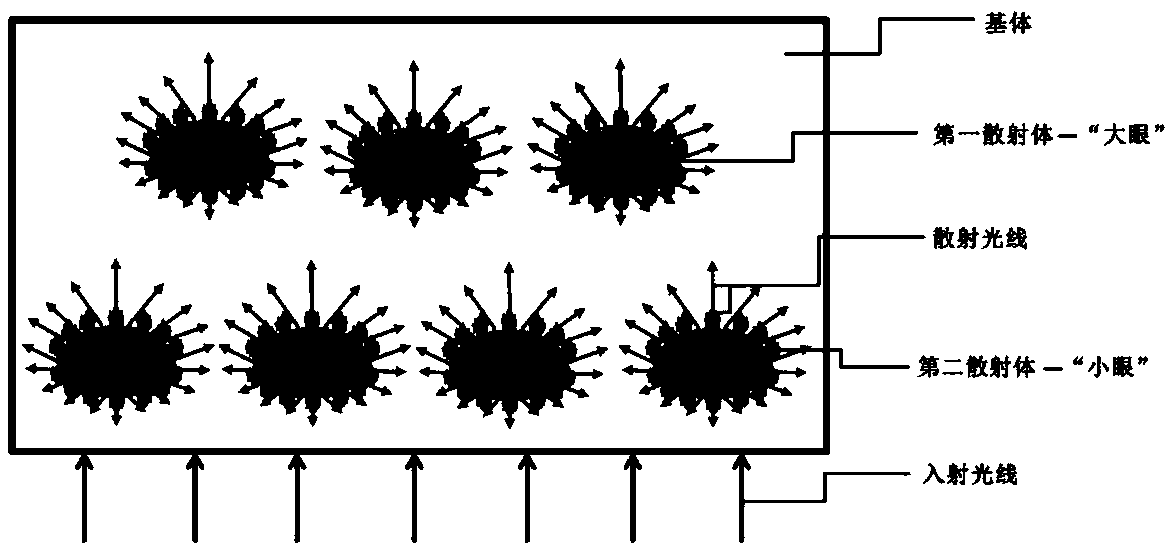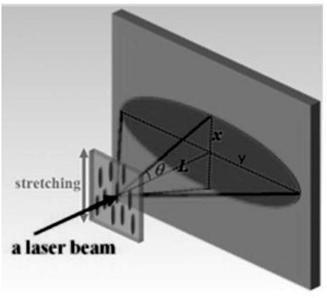Method for increasing scattering angle of short-axis scattering direction of anisotropic light-scattering material
An anisotropic and directional scattering technology, applied in the field of polymer matrix composite material preparation technology, can solve the problems of small scattering angle and narrowing scattering angle, and achieve the effect of large scattering angle
- Summary
- Abstract
- Description
- Claims
- Application Information
AI Technical Summary
Problems solved by technology
Method used
Image
Examples
Embodiment 1
[0037] 70 parts by mass of polycarbonate (PC), 30 parts by mass of acrylonitrile copolymer (SAN) and 1.7%, 3.3%, 5.0%, 6.7% of the total weight of SAN, respectively, polymethylsilsesquioxane with a diameter of 10um Polycarbonate beads (OSB3) were melted and blended by a torque rheometer, and granulated to obtain polycarbonate composite particles. The composite particles were molded at 240°C into 100.0mm (length) × 30.0mm (width) × 1mm ( thick) samples. Then the sample was fixed in a high-temperature universal tensile testing machine and thermally stretched at 190°C with a stretch ratio of 2. The scattering angles in the short-axis scattering direction (x direction) are 18.7º, 20.1º, 20.8º, 22.0º, respectively, and the scattering angles in the long-axis scattering direction (y direction) are 30.2º, 30.9º, 31.0º, 32.3º, respectively. .
Embodiment 2
[0039] 30 parts by mass of acrylonitrile copolymer (SAN) were mixed with 1.7%, 3.3%, 5.0%, and 6.7% of the total weight of SAN with nano-calcium carbonate (nano-CaCO3) after surface treatment with a silane coupling agent. 3 ) was extruded at 200°C with a micro-blending extrusion rheometer, pelletized, and the pelletized SAN / nano-CaCO 3 The blend and 70 parts by mass of polycarbonate (PC) were melt-blended in a torque rheometer and granulated at a temperature of 240°C to obtain polycarbonate composite particles. The composite particles were heated at 240°C Molded into a sample of 100.0mm (length) × 30.0mm (width) × 1mm (thickness). Then the sample was fixed in a high-temperature universal tensile testing machine and thermally stretched at 190°C with a stretch ratio of 2. The scattering angles in the short-axis scattering direction (x direction) were measured to be 33.2º, 35.9º, 39.9º, 41.1º, and the scattering angles in the long-axis scattering direction (y direction) were 55....
Embodiment 3
[0041]70 parts by mass of polycarbonate (PC), 30 parts by mass of acrylonitrile copolymer (SAN) and 3.3% of the total weight of SAN polymethylsilsesquioxane beads (OSB1) with a diameter of 2um were subjected to torque flow Polycarbonate composite particles were obtained by melt blending and granulation, and the composite particles were molded at 240°C into a sample of 100.0 mm (length) × 30.0 mm (width) × 1 mm (thickness). Then the samples were fixed in a high-temperature universal tensile testing machine and thermally stretched at 190°C, and the stretching ratios were 2 and 2.5, respectively. The scattering angles in the short-axis scattering direction (x direction) are measured as 27.4º and 23.8º, and the scattering angles in the long-axis scattering direction (y direction) are 33.4º and 31.0º.
PUM
| Property | Measurement | Unit |
|---|---|---|
| heat deflection temperature | aaaaa | aaaaa |
Abstract
Description
Claims
Application Information
 Login to View More
Login to View More - R&D
- Intellectual Property
- Life Sciences
- Materials
- Tech Scout
- Unparalleled Data Quality
- Higher Quality Content
- 60% Fewer Hallucinations
Browse by: Latest US Patents, China's latest patents, Technical Efficacy Thesaurus, Application Domain, Technology Topic, Popular Technical Reports.
© 2025 PatSnap. All rights reserved.Legal|Privacy policy|Modern Slavery Act Transparency Statement|Sitemap|About US| Contact US: help@patsnap.com


